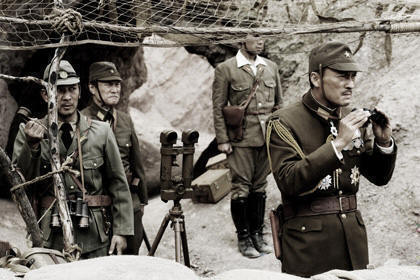![]()
![]()
![]()
![]()
![]()
![]()
![]()
![]()
![]()
![]()
3. LETTERS FROM
IWO JIMA

(Photo and poster: Warner Brothers)
By Omar P.L. Moore/The
Popcorn Reel
Clint
Eastwood does something very special here: he tells the story of the 1945 Battle
Of Iwo Jima from the Japanese perspective -- not something that the winning (or
losing) sides in a war are apt to tell accurately. After all, history is
written by its victors, as the saying goes. With very few flaws Eastwood
tells the story marvelously, through both his direction and fine acting from Ken
Watanabe in particular. The famed director, on his way (if he's not
already there) to becoming one of
the great directors of his generation if he continues to tell superb stories
like this, has the indispensable help of Iris Yamashita, a Japanese woman born
in the United States who wrote and adapted the screenplay from the actual
letters of the real-life Lieutenant General Kuribayashi (played by Watanabe in
the film) and the authenticity is reflected on screen.
Eastwood and his
team did incredibly thorough research for the film. "Letters From Iwo Jima"
is about a group of Japanese soldiers who essentially wait to die in their
fierce battle to protect their homeland from invasion by the Americans.
The Japanese men take time to think about their own existence. They know
their fate and are resigned to it. They fight valiantly, dying for
honorable and not cowardly reasons, and they spend their days attempting to
reconnect through the written word with the families they have left behind in
favor of the country that implores them to fight on to the death in what has
become a futile exercise. Nonetheless, despite overwhelming odds and being
heavily outnumbered, the soldiers fought on for much longer than was expected --
about 45 days. All told, more than 20,000 Japanese soldiers died.
Acts of bravery, courage and kindness under both duress and contemplation
defined their struggle. War is not the answer, as Marvin Gaye once sung.
The film resists most of the cliches and stereotypes of Japanese that have
plagued numerous other American films. Even in one of the film's weakest
scenes the men come to understand that the American and Japanese soldiers have
much in common with each other. Shot in very faded color so as to make it
for all intents and purposes a black and white film, "Letters" is a
one-of-a-kind motion picture that harkens back to the story telling of the
1930's and 1940's, the golden era of American movies when special effects rarely
intruded and the acting truly was the biggest star of all. Paul ("Crash")
Haggis assisted in the script with Ms. Yamashita and Steven Spielberg was among
the producers of this film, the companion to Mr. Eastwood's earlier film "Flags
Of Our Fathers", which was a very good film by itself. "Flags"' stronger
companion expands across the United States on January 19 and continues its run
in Japan -- where it has been seen and admired by many for almost a full month
-- while soon making its way around the globe.
The PopcornReel.com "Letters From Iwo Jima" film
review first appeared
on December 20, 2006.
![]()
![]()
![]()
![]()
![]()
![]()
![]()
![]()
![]()
![]()